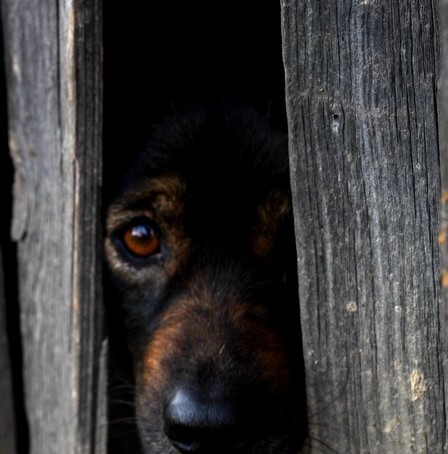

If a dog is afraid, there are many different possible causes. Regardless of the exact trigger, it is ultimately your responsibility to recognise the problem and help your anxious dog overcome it.
After all, it is quite possible that initially harmless fears will increase over time and a fear dog may even become a danger to itself and its environment. By taking action in time, you can prevent this.
In the following we will explain how you can best do this and why dogs can be afraid at all.
The causes that can lead to an anxious dog are numerous. They range from typical breed characteristics to physical problems. This sometimes makes it difficult to recognise why exactly a dog is afraid.
It may well be that your dog has learned that he should be afraid in certain situations. This may be the case, for example, if his mother was particularly anxious and her fear has spread to the puppies.
It is also possible that your four-legged friend has had bad experiences at some point in his life. Especially if you adopt a dog from an animal shelter or from an animal protection organization, you usually do not know what he has already experienced.
Another possible reason why a dog is afraid is existing problems with its health. Perhaps the quadruped has pain that frightens him. It is also possible that he suffers from hormonal disorders or poisoning.
If you cannot explain the fear in your dog and he seems insecure without any visible reason, a thorough examination by the vet can help to get to the bottom of the cause and take any necessary treatment measures.

Not all dog breeds are characterized by a robust character. Some breeds are naturally more sensitive and react more sensitively to stimuli from their environment. In most cases this is related to their original purpose.
While in some animals in breeding, special attention was paid from the beginning to a courageous and fearless character, in others this was simply not necessary. This does not mean, of course, that these dogs are particularly fearful in any case. Nevertheless, this circumstance can still be reflected in their character today.
Changes in the environment are another possible trigger for fear in dogs. For example, if you move with your four-legged friend from a small village in the country to a large city, you should be aware that there is much more noise and hectic activity.
We humans know, of course, that this is something quite normal and that things like traffic noise do not pose any danger at first. With dogs, however, the situation is different. They suddenly find themselves confronted with a completely new environment. This can easily lead to a dog being afraid and, at least at the beginning, being very insecure.
In order to be able to counteract the fear as a keeper, it is of course important to recognize a fearful dog. First signs of insecurity are usually a drawn-in tail, tense muscles and a slightly crouched posture.
The more anxious a dog becomes, the more it usually ducks. Many four-legged friends also begin to tremble and pant particularly strongly. Note that a dog that is afraid should not be pushed too hard. Because that can lead under circumstances to the fact that the quadruped only knows how to help himself by biting.

If you observe first signs of insecurity in your four-legged friend, it is very important that you do not become nervous yourself. After all, your four-legged friend is orienting himself towards you. If an anxious dog notices that its leader remains relaxed, it will therefore be much easier to calm down again.
Always offer your dog protection when he is scared. Talk to him well and show him that he can rely on you. However, be careful not to overdo it with comforting your dog so as not to confirm his fears.
However, you should avoid scolding or even punishing your timid dog. This will only make things worse and the fear may be even greater next time.
Always remember that trust is the most important thing in the relationship with your four-legged friend. Your anxious dog should always know where he stands with you and that he can rely on you.
If your dog is always afraid in certain situations, it can be quite useful to counteract his fear with training.
To do this, you need to gradually introduce him to the situation that triggers the fear, making sure that he associates it with something positive. This could be, for example, a tasty dog snack that you give him at the right time, or a joint game that you play at some distance from the fear trigger.
However, be careful not to overtax your anxious dog. Even if you would like to see your dog progress as quickly as possible, you should not confront him with his fear at every opportunity. Give him the opportunity to process his experience and slowly get used to it.
You should also be aware that you need to address different fear triggers separately and that you should not push your dog to do anything when he is completely frightened.
If you notice that you are not getting anywhere with your anxious dog on your own, it may also be a good idea to seek the help of a professional dog trainer.
One or two dog owners may think about simply giving their scare dog a sedative. In practice, however, this proves to be a very bad idea. Because chemical tranquilizers may calm your anxious dog. But they do not relieve his fear.
However, to help your anxious dog relax, we recommend that you use a natural product like Shiimun Calm instead.
Shiimun Calm is a high-quality dietary supplement for dogs. Selected ingredients such as shiitake, brewer's yeast and L-tryptophane provide your dog with numerous valuable nutrients that contribute to an increased sense of well-being.
Shiimun Calm is therefore ideally suited to counteract nervousness and fear in dogs and to calm your four-legged friend in a natural and digestible way, even in extreme situations.

